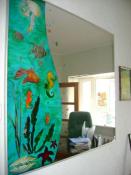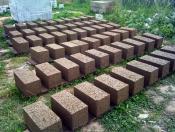Search
Login
Recommended
Everything you need to know about drywall
If you are tired of construction debris and dirt, then the use of drywall, using dry construction technology, will allow you to do without dirty work in the finishing process.
Content
- Drywall Composition
- Drywall Selection
- Benefits video
- Drywall Use
- Installation Difficulties video
- Preparation for finishing
- DIY plasterboard slopes
- Why cracks appeared at the junction video
Drywall Composition
Drywall is produced in the form of a rectangular, flat construction sheet. Since drywall is made from natural materials, it does not contain harmful ingredients, it does not emit allergens, does not smell.
The drywall sheet consists of a gypsum core, lined with strong cardboard on both sides. Adhesive additives provide strong adhesion of the core to the cardboard, the longitudinal edges are rolled up with cardboard, the end edges are open, evenly cut. Drywall sheets have high porosity, are able to breathe.
This material has a unique ability to regulate the humidity of the room, with an excess of air humidity, it absorbs it, accumulates it, and when it drops in moisture, it gives, i.e. maintains a comfortable microclimate in the room.
Standard sheets have a thickness of 9.5 mm. and 12 mm., 600 mm wide. and 1200 mm., length 2500 mm. and 3000 mm. Sheets of other sizes are made to order.
Drywall Selection
The indicator of the quality of the drywall sheet is the optimal density of the core. The average weight of one square meter of drywall is 9-10 kg., The weight of a standard sheet of size 2500x1200 and 12.5 mm., Is from 27 to 29 kg.
With standard thinking, we believe that the denser the better, based on the fact that the sheet is stronger, it will not break during transportation, but when faced with fastening to a metal profile, you will understand that this is an insoluble task, since self-tapping can not push the core and make a thread in the metal, the drywall sheet is destroyed, the metal profile is spoiled.
Problems arise when using sheets with high porosity of gypsum. Although it’s easier to work with it, the sheet weight is less, the self-tapping screw easily passes through, but the core, however, usually crumbles and the sheet does not fit snugly to the profile, and the self-tapping screws, when installed, should fit into the drywall at right angles and go beyond profile for a length of at least 10 mm. and if in the core of the drywall sheet the pores are of different sizes, then the cutting produces an uneven edge and needs to be further processed.
In this regard, many manufacturers use new blowing agents, the result of the new formulation is that the sheet breaks exactly along the line and forms an even end. It is convenient to use drywall sheets with a bevel on the front side to the side of the edge, after puttying, when using reinforcing tapes, the joints of such sheets are not at all noticeable.
When purchasing drywall, pay attention to the width of the thinning of the edge, for high-quality drywall, the width of thinning along the entire length of the edge is the same, and for low-quality - different, at the top it can be 2 cm., And at the bottom - 4 cm. When using such sheets, at the joints of the edges the reinforcing tape will extend beyond the thinning band and a mound may form on the surface of the sheet.
Benefits
Applying drywall for the construction of partitions instead of brick or concrete, thereby reducing the load on the load-bearing elements of the building by 7–9 times, reducing the cost of laying the foundation, possibly increasing the number of storeys of the house, and reducing construction costs.
Lightweight constructions made of drywall sheets are also actively used to repair old buildings. During the reconstruction, with his own hands, the owner mounts plasterboard ceilings, builds partitions, makes beautiful plasterboard arches, mounts walls, easily builds niches.
When using this building material, there is no need for wet and dirty processes during decoration, installation is quick. In the wet state, drywall becomes flexible, and after drying, returns to its original state.
Drywall Use in Wet Conditions
For finishing bathrooms and kitchens, there is a moisture-proof drywall, in the production of such drywall, special substances are introduced into the core, they reduce moisture absorption and are not afraid of air humidity up to 70%.
But rooms with high humidity must be equipped with exhaust ventilation, and the front surface of the sheet must be waterproofed with moisture-resistant paint or ceramic tile. The moisture-resistant sheet differs from the usual color, in the production of green pigment is added to the facing layer of drywall.
Installation Difficulties
Since gypsum plasterboard sheets are mounted to the crate, this design thereby reduces the volume of the room, the loss of precious area for a room of 20 square meters, is about 0.5 square meters.
But this installation has its advantages: in the cavity you can lay electrical wiring, the air layer inside the partition, improves sound insulation. But there is a drawback in the fact that on a wall or partition made of drywall with a frame structure, if you did not reinforce this section with embedded elements in advance, it is difficult to hang a cabinet or shelves.
There is another installation technology that avoids these limitations. With this installation, directly onto the brickwork, in a continuous layer, 10-15 mm thick. they apply special gypsum glue, it fills the bumps, and a hard sheet of drywall provides a smooth surface.
The advantage of this installation: useful centimeters of the area are saved, the ability to use the bearing capacity of the wall, the absence of voids in the wall that attract insects and rodents.
Preparation for finishing
When preparing the surface for painting, plastering, or wallpapering, it is necessary to fix the joints: they are puttyed, then a reinforcing tape is laid, on top of it again is a putty coat. Protective corner metal profiles for door and window openings and external corners of walls are installed on the putty.
When installing drywall, it is necessary to observe the maximum deviation of the plane of walls and ceilings vertically and horizontally: 1 mm. 1 meter, but not more than 5 mm. the entire height or length of the plane. Deviation of window and door slopes should be no more than 1 mm. by 1 meter of length or height and not more than 3 mm. to the window or door.
Finishing, largely depends on the type of decorative coating. The base for painting is especially carefully prepared, the presence of shells, kinks, and inflows of putty mortar is not permissible here; it is necessary to create an imperceptible transition from putty joints to the main surface.
Finishing putty on walls and ceilings should remove the above errors completely.
DIY plasterboard slopes
Drywall installation must be carried out in conditions as close as possible to operational. To get the edge of the sheet at a certain angle, use an edge planer, plastic grout removes burrs, a spatula for internal corners, will help to get a perfectly even joint.
When decorating window slopes, use moisture-resistant sheets, they are fixed with screws or glued. If the sheets are glued, then high-quality thermal insulation of the walls is necessary so that the walls in contact with the adhesive do not freeze.
It is necessary to exclude all cracks and ensure tightness at the junction of the window to the opening. When mounting slopes, first protect the window frame with duct tape.
Cover the gypsum board with soil, and reinforce the joints of individual sheets with a sickle (adhesive net tape), then carefully plaster the surface, install metal corners on the outer corners and plaster again. The slope is ready.
Why cracks appeared at the junction
The main causes of cracks at the joints of individual sheets are the failure to comply with the installation and operation technology. If the purchased sheets were stored in the open air, then the joints were immediately attached and putty, then after two, three days excess moisture will leave the sheet, it will decrease in size, cracks will form at the seams.
Therefore, it is necessary to strictly observe the rules for working with drywall, and during operation, maintain normal temperature and humidity conditions.
If the material was stored indoors before purchase, at a temperature not exceeding 0 degrees, it must be kept at room temperature for 24 hours before installation, and if it was stored in an open area, it should be kept for two days.





